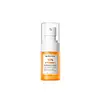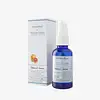What's inside
What's inside
 Key Ingredients
Key Ingredients

 Benefits
Benefits

 Concerns
Concerns

 Ingredients Side-by-side
Ingredients Side-by-side

Water
Skin ConditioningAscorbic Acid
AntioxidantButylene Glycol
HumectantGlycerin
HumectantTranexamic Acid
AstringentBetaine
HumectantPEG/PPG-17/6 Copolymer
Solvent1,2-Hexanediol
Skin ConditioningHydroxyacetophenone
AntioxidantBis-PEG-18 Methyl Ether Dimethyl Silane
EmollientAcrylates/C10-30 Alkyl Acrylate Crosspolymer
Emulsion StabilisingTocopherol
AntioxidantCitrus Reticulata Fruit Extract
Skin ProtectingHydrolyzed Sodium Hyaluronate
Skin Conditioning3-O-Ethyl Ascorbic Acid
Skin ConditioningAminomethyl Propanol
BufferingAlgin
MaskingPentylene Glycol
Skin ConditioningSodium Hyaluronate
HumectantErgothioneine
AntioxidantFerulic Acid
AntimicrobialSodium Acetylated Hyaluronate
HumectantSodium Hyaluronate Crosspolymer
HumectantCitrus Reticulata Peel Extract
Skin ConditioningNonapeptide-1
Skin ConditioningHexapeptide-2
BleachingHexapeptide-9
Skin ConditioningOligopeptide-1
Skin ConditioningLaminaria Digitata Extract
Skin ProtectingCeramide AP
Skin ConditioningCeramide As
Skin ConditioningCeramide Ns
Skin ConditioningCeramide EOP
Skin ConditioningCeramide NP
Skin ConditioningCetyl-Pg Hydroxyethyl Palmitamide
Skin ConditioningHydrogenated Lecithin
EmulsifyingCholesterol
EmollientAllantoin
Skin ConditioningPPG-26-Buteth-26
Skin ConditioningPEG-40 Hydrogenated Castor Oil
EmulsifyingPvm/Ma Copolymer
Emulsion StabilisingGlyceryl Acrylate/Acrylic Acid Copolymer
HumectantPolysorbate 20
EmulsifyingEthylhexylglycerin
Skin ConditioningWater, Ascorbic Acid, Butylene Glycol, Glycerin, Tranexamic Acid, Betaine, PEG/PPG-17/6 Copolymer, 1,2-Hexanediol, Hydroxyacetophenone, Bis-PEG-18 Methyl Ether Dimethyl Silane, Acrylates/C10-30 Alkyl Acrylate Crosspolymer, Tocopherol, Citrus Reticulata Fruit Extract, Hydrolyzed Sodium Hyaluronate, 3-O-Ethyl Ascorbic Acid, Aminomethyl Propanol, Algin, Pentylene Glycol, Sodium Hyaluronate, Ergothioneine, Ferulic Acid, Sodium Acetylated Hyaluronate, Sodium Hyaluronate Crosspolymer, Citrus Reticulata Peel Extract, Nonapeptide-1, Hexapeptide-2, Hexapeptide-9, Oligopeptide-1, Laminaria Digitata Extract, Ceramide AP, Ceramide As, Ceramide Ns, Ceramide EOP, Ceramide NP, Cetyl-Pg Hydroxyethyl Palmitamide, Hydrogenated Lecithin, Cholesterol, Allantoin, PPG-26-Buteth-26, PEG-40 Hydrogenated Castor Oil, Pvm/Ma Copolymer, Glyceryl Acrylate/Acrylic Acid Copolymer, Polysorbate 20, Ethylhexylglycerin
Water
Skin ConditioningPropylene Glycol
Humectant3-O-Ethyl Ascorbic Acid
Skin ConditioningHydroxyethylcellulose
Emulsion StabilisingSalicylic Acid
MaskingAlcohol
AntimicrobialTocopheryl Acetate
AntioxidantAmylopectin
Dextrin
AbsorbentXanthan Gum
EmulsifyingDMDM Hydantoin
PreservativeTetrasodium EDTA
Tranexamic Acid
AstringentSodium Hyaluronate
HumectantParfum
MaskingButylene Glycol
HumectantIodopropynyl Butylcarbamate
Preservative
 Reviews
Reviews

Ingredients Explained
These ingredients are found in both products.
Ingredients higher up in an ingredient list are typically present in a larger amount.
You might know this ingredient as Ethyl Ascorbic Acid, a more stable version of ascorbic acid.
Like other types of vitamin C, this ingredient has many benefits including reducing wrinkles, skin soothing, dark spot fading, and fighting against free radicals.
3-O-Ethyl Ascorbic Acid interferes with the process of skin darkening, helping to reduce hyperpigmentation. It also encourages the skin to produce more collagen.
Once applied, 3-O-Ethyl Ascorbic Acid is converted to Vitamin C deeper in the skin's layers. This process is slow but makes this ingredient more tolerable for skin.
The optimum pH range for this ingredient is 4 - 5.5
Learn more about 3-O-Ethyl Ascorbic AcidButylene Glycol (or BG) is used within cosmetic products for a few different reasons:
Overall, Butylene Glycol is a safe and well-rounded ingredient that works well with other ingredients.
Though this ingredient works well with most skin types, some people with sensitive skin may experience a reaction such as allergic rashes, closed comedones, or itchiness.
Learn more about Butylene GlycolSodium Hyaluronate is hyaluronic acid's salt form. It is commonly derived from the sodium salt of hyaluronic acid.
Like hyaluronic acid, it is great at holding water and acts as a humectant. This makes it a great skin hydrating ingredient.
Sodium Hyaluronate is naturally occurring in our bodies and is mostly found in eye fluid and joints.
These are some other common types of Hyaluronic Acid:
Learn more about Sodium HyaluronateTranexamic Acid is best used for treating hyperpigmentation, discoloration, and melasma. It can also help build a stronger skin barrier.
Once applied, Tranexamic Acid starts decreasing inflammation from UV exposure. Tranexamic Acid also prevents our skin cells from meeting the pigment production cells.
Its brightening property makes it great at reducing the appearance of acne scars and marks.
Fun fact: Tranexamic Acid is also a medication used to reduce heavy bleeding.
This acid is derived from lysine, an amino acid.
Learn more about Tranexamic AcidWater. It's the most common cosmetic ingredient of all. You'll usually see it at the top of ingredient lists, meaning that it makes up the largest part of the product.
So why is it so popular? Water most often acts as a solvent - this means that it helps dissolve other ingredients into the formulation.
You'll also recognize water as that liquid we all need to stay alive. If you see this, drink a glass of water. Stay hydrated!
Learn more about Water